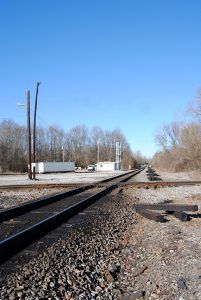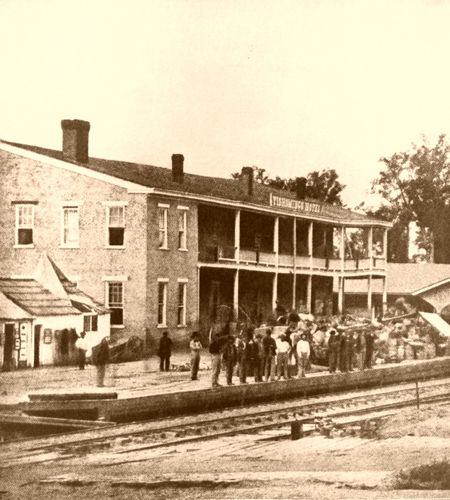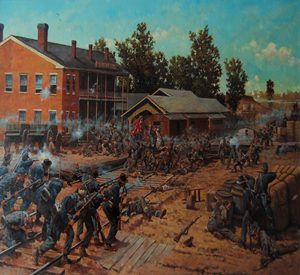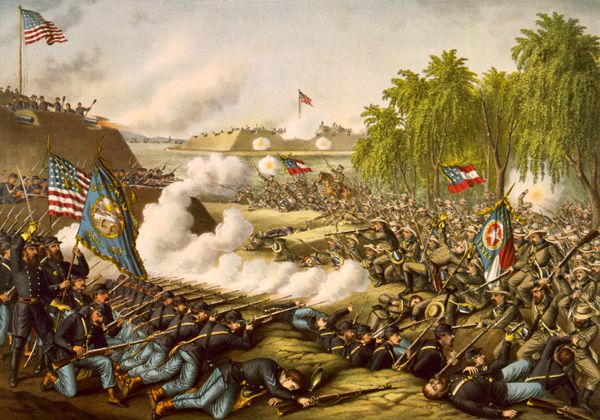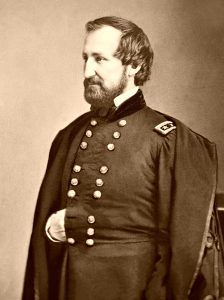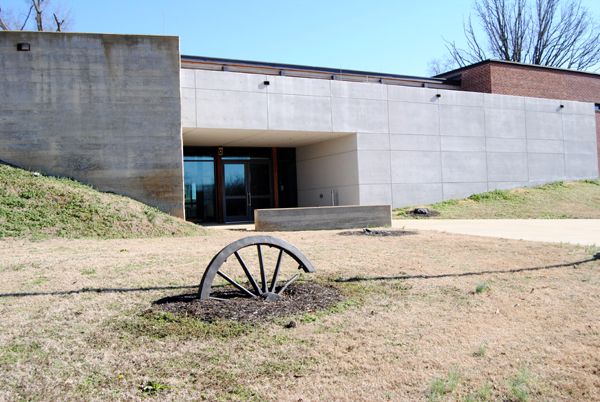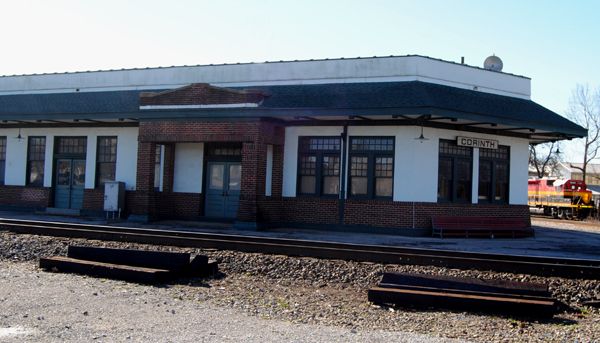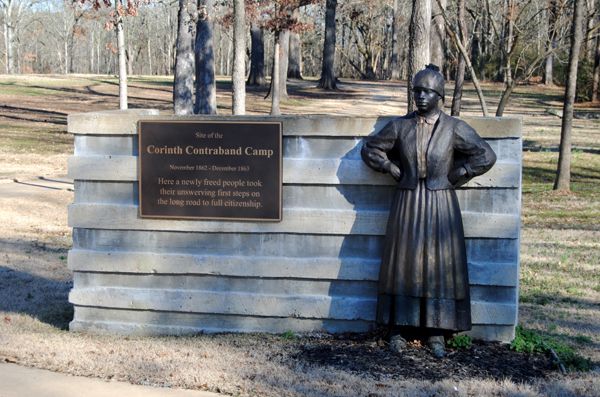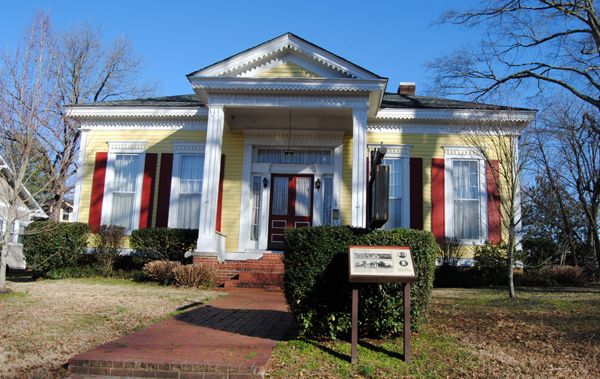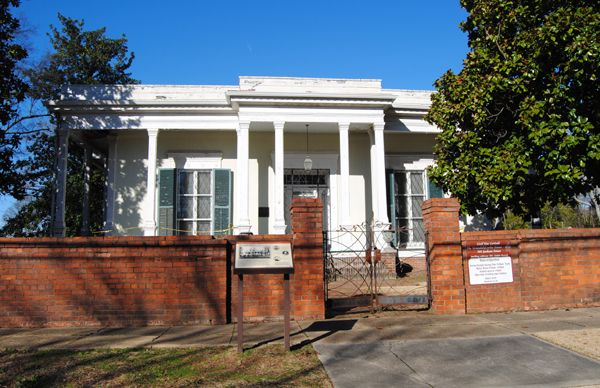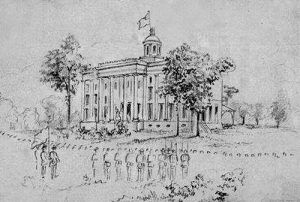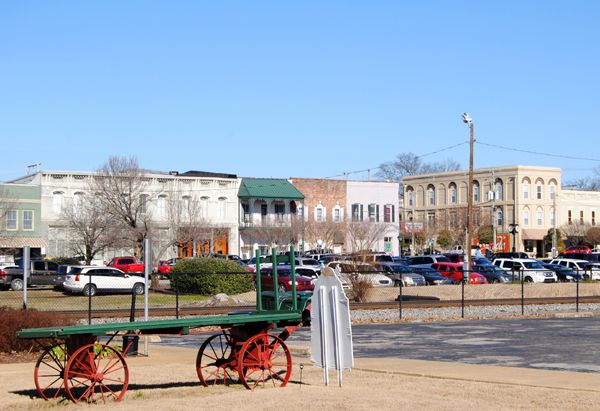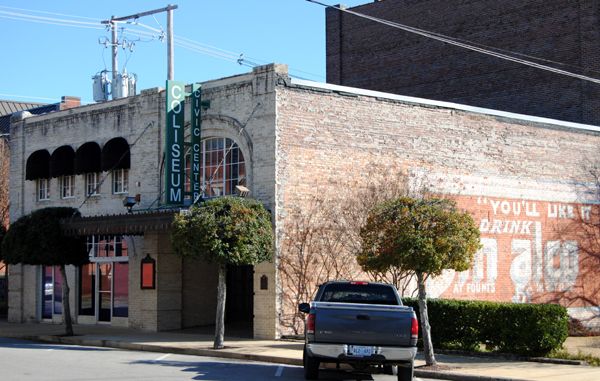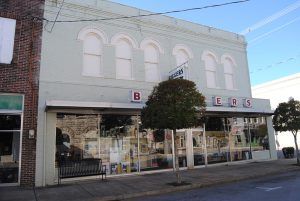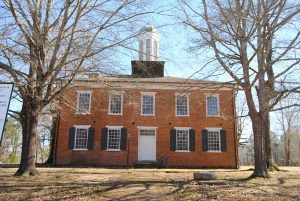In 1854, the citizens of Tishomingo County invited two railroad companies, the Mobile & Ohio and the Memphis & Charleston, to build lines through the largely agricultural area. Within a year, the companies completed their surveys and their two routes intersected in the north-central Tishomingo County. A small town grew up at the crossroads of the two new railroad lines, originally called Cross City. By 1855, the rapidly growing town changed its name to Corinth, after the crossroads city of ancient Greece. By 1860, Corinth was called home to about 1,500 people. When the Civil War began in 1861, both Confederate and Union strategists recognized the importance of controlling Corinth due to its junction of two major rail lines. The town would become the site of two significant engagements, a siege of the town in spring 1862 and a bloody conflict in the fall of the same year.
The tracks still cross in the center of town, and trains still use them, but no one fights over them anymore. During the Civil War as many as 300,000 soldiers moved through this tiny town in northeastern Mississippi as the Union and the Confederacy fought to control the critical railroad crossroads. The evidence of their presence is everywhere.
A reconstructed earthen redoubt commemorates the men in gray who marched with slow and steady steps against its walls and the men in blue who defended it in fierce hand-to-hand combat. And, if you look carefully, you can see miles and miles of earthen fortifications, some built to protect the crossover and some to help seize it. These trenches testify to a new kind of warfare that was tested here and would become common before the war ended in 1865.
In the years since the Civil War, Corinth has grown into a small city of about 14,000 people, but the general landscape has changed little.
The Siege of Corinth
At the end of April 1862, Union Major General Henry W. Halleck’s powerful Army group of almost 125,000 men, set out from Pittsburg and Hamburg landings in Tennessee towards Corinth, Mississippi. A Confederate force of about half that size, under the command of General P.G.T. Beauregard, waited for them, behind five miles of newly-constructed earthworks. Both commanders knew the importance of the coming battle. Halleck claimed that the railroad centers in Richmond, Virginia, and Corinth were “the greatest strategic points of the war, and our success at these points should be insured at all hazards.” Beauregard told his superiors: “If defeated here we will lose the Mississippi Valley and probably our cause . . . and our independence.”
It took Halleck a month to travel the 22 miles to Corinth. The route crossed a series of low ridges covered with dense forests and cut by stream valleys and ravines. Moving his army through the rugged country while keeping it aligned along a 10-mile front, was slow and difficult work. The weather was bad and there was little good water. Dysentery and typhoid were common.
By May 2nd, the Union troops had closed to within 12 miles of Corinth and felt its way forward from one line of entrenchments to another. The Confederates had constructed a defensive line of earthworks anchored on the Memphis and Charleston Railroad to the west, continuing around to the north of Corinth, crossing the Mobile and Ohio Railroad and Purdy Road, then turning south following the high ground commanding Bridge Creek and crossing the Memphis and Charleston Railroad well east of the crossover, and anchoring on the Danville Road, one-half mile east of the Mobile and Ohio. These earthworks guarded the eastern and northern approaches to Corinth.
By May 4th, the Union army was within 10 miles of Corinth and the railroads. The Confederates began a series of small-scale attacks, keeping up nearly constant harassment. Halleck, cautious by nature, established an elaborate procedure to protect his army as they advanced. As the troops moved up to a new position, they worked day and night digging trenches. These “were made to conform to the nature of the ground, following the crest of the ridges… They consisted of a single ditch and a parapet… only designed to cover our infantry against the projectiles of the enemy.” As each line of earthworks was finished, the men advanced about a mile and then started digging a new line of trenches. Eventually, there were seven progressive lines and about 40 miles of trenches. Their work was described as the “most extraordinary display of entrenchment under offensive conditions witnessed in the entire war.”
The Confederates waiting in Corinth were well aware of Halleck’s slow, but constant, advance. In May, a Confederate soldier wrote his wife:
“I can sit now in my tent and hear the drums and voices in the enemy lines, which cannot be more than two miles distant. We have . . . killed and wounded every day… The Yanks are evidently making heavy preparation for the attack which cannot, I think, be postponed many days longer… Everything betokens an early engagement so make it be, for I am more than anxious that it shall come without further delay.”
On May 21st, General Beauregard planned a counterattack, an attempt to “draw the enemy out of its entrenched positions and separate his closed masses for a battle.” The gamble came to naught because of delays in getting the troops in position to attack.
By May 25th, the long Union line was entrenched on high ground within a few thousand yards of the Confederate fortifications. From that range, Union guns shelled the Confederate defensive earthworks, and the supply base and railroad facilities in Corinth. Beauregard was outnumbered two to one. The water was bad. Typhoid and dysentery had felled thousands of his men. At a council of war, the Confederate officers concluded that they could not hold the railroad crossover.
Beauregard saved his army by a hoax. Some of the men were given three days’ rations and ordered to prepare for an attack. As expected, one or two went over to the Union with that news. During the night of May 29th, the Confederate army moved out. They used the Mobile and Ohio Railroad to carry the sick and wounded, the heavy artillery, and tons of supplies. When a train arrived, the troops cheered as though reinforcements were arriving. They set up dummy guns along the defensive earthworks. Campfires were kept burning, and buglers and drummers played. The rest of the men slipped away undetected. When Union patrols entered Corinth on the morning of May 30th, they found the Confederates gone.
During the siege, there were some 120,000 Union troops and 70,000 Confederate troops engaged. Each side had estimated casualties of about 1,000 men. Most historians believe that the Union seizure of the strategic railroad crossover at Corinth led directly to the fall of Fort Pillow, Tennessee on the Mississippi River, the loss of much of Middle and West Tennessee, the surrender of Memphis, and the opening of the lower Mississippi River to Federal gunboats as far south as Vicksburg. No Confederate train ever again carried men and supplies from Chattanooga to Memphis.
The Battle of Corinth
After the Confederates evacuated Corinth, Union soldiers occupied the town. They spent most of the long, hot summer digging wells to find good water and building additional fortifications. General Halleck ordered the construction of a series of larger earthwork fortifications called “batteries,” designed to hold cannon to protect Corinth against Confederate forces approaching from the west or south. His successor, Major General William S. Rosecrans, concentrated on protecting the railroad crossover and its vital supplies. He built an inner series of batteries on the ridges immediately around the town. Trenches for infantrymen connected the batteries and masses of sharpened logs pointing outward (the Civil War equivalent of barbed wire) strengthened the line.
In the summer and early fall of 1862, the military situation changed dramatically. The South seized the initiative from Virginia to the Mississippi River and beyond. In hard-fought battles, the Confederates carried the fighting to the North. On the all-important diplomatic front, the British government seemed on the verge of recognizing the Confederacy as an independent country.
In September, many of the men at Corinth went off to fight a bloody battle at Iuka, Mississippi successfully blocking a Confederate move into middle Tennessee. On October 2nd, General Rosecrans learned that the Confederates were approaching from the northwest. The two armies each had 22,000-23,000 men; but, Rosecrans’ position behind his defensive earthworks was a strong one. He stationed his advance guard about three miles beyond the town limits. On October 3rd, Union and Confederate forces clashed initially in the area fronting the old Confederate earthworks. In heavy fighting throughout the day, the Confederates pushed Union forces back about two miles. Confederate Major General Earl Van Dorn, certain he could win an overwhelming victory in the morning, called a halt to the fighting about 6:00 p.m. His troops, parched and exhausted from lack of water and 90-degree heat, camped for the night, some only a few hundred yards from the inner fortifications where Union troops had taken refuge.
During the night, Union commanders moved their men into a more compact position closer to Corinth, covering the western and northern approaches to the community. The partially entrenched line was less than two miles long and was strengthened at key points by the cannons of the batteries named Tannrath, Lothrop, and Phillips located on College Hill southwest of the town; batteries Williams and Robinett, positioned overlooking the cut of the Memphis and Charleston Railroad immediately west of the rail junction; and an unfinished Battery Powell, still being built on the northern outskirts of Corinth.
Before dawn on October 4th, the Confederates woke the Union troops with artillery fire, but, things quickly began to go wrong. The general who was to lead the opening attack had to be replaced, causing confusion and delay. But, about 9:00 a.m. the Confederates opened a savage attack on the Union line. Some of the Confederates fought their way into the town. Battery Powell changed hands twice in fierce fighting. About 10:00 a.m., four columns of gray-clad Confederates advanced on Battery Robinett. The men inside the battery watched them come, one describing it:
“As soon as they were ready they started at us with a firm, slow, steady, step. In my campaigning, I had never seen anything so hard to stand as that slow, steady tramp. Not a sound was heard but, they looked as if they intended to walk over us. I afterward stood a bayonet charge . . . that was not so trying on the nerves as that steady, solemn advance.”
A man from an Alabama regiment described the scene from the Confederate side:
“The whole of Corinth, with its enormous fortifications, burst upon our view. The United States flag was floating over the forts and in town. We were met by a perfect storm of grapeshot, canister, cannonballs, and mini balls. Oh God! I have never seen the like! The men fell like grass.”
Four times they charged, each time being mowed down by withering fire from the cannons of batteries Robinett and Williams and from the muskets of the men lined up in the field next to the batteries. After desperate fighting, a Union bayonet charge broke the enemy columns and drove them back. By noon, Van Dorn’s army was in retreat. Rosecrans did not pursue the retreating army until the next day, and eventually, Van Dorn managed to save his army. During the battle, there were some 23,000 Union soldiers engaged resulting in 2,359 casualties. Of the Confederate Army, some 21,000 soldiers were involved, resulting in 4,388 casualties. Union victories at Corinth, Antietam, Maryland, and Perryville, Kentucky set the stage for Lincoln’s Emancipation Proclamation and helped prevent the British and the French from recognizing the Confederacy. The Confederacy never recovered from its losses in September and October 1862.
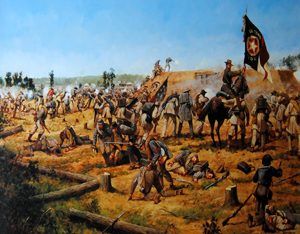
The struggle over Corinth and its railroad crossroads would go on for some six months
The Union continued to occupy Corinth for the next 15 months, using it as a base to raid northern Mississippi, Alabama, and southern Tennessee. Control of Corinth and its railroads opened the way for Union victory at Vicksburg, Mississippi in July 1863. On January 25, 1864, Union troops left the town. The Confederates returned, but, it was too late. The South had not built a single locomotive since 1861 and could no longer take advantage of the once critical railroad lines. The only cars moving on the patched-together tracks were pulled by mules.
Today, the Corinth Battlefield Unit contains numerous historic sites associated with the siege, battle, and occupation of the city during the Civil War. Several miles of rifle-pits, trenches, artillery positions and the earthworks of Batteries F and Robinett still exist. Located near the site of Battery Robinett, the Corinth Civil War Interpretive Center is open from 8:00 am to 5:00 pm every day except December 25. The center exhibits include interactive displays and multimedia presentations on the Battle of Shiloh and the Siege and Battle of Corinth. Elsewhere can be found the historic depot which houses a museum, the National Cemetery, Contraband Camp, historic homes where officers were housed, and more.
Civil War Trail guides are available at several locations throughout Corinth — at the Corinth Civil War Interpretive Center, the Mississippi Welcome Center, and the Crossroads Museum at the Historic Corinth Depot. The museum also offers a free CD which narrates the tour.
Historic Civil War Sites:
1. Corinth Civil War Interpretive Center at Battery Robinett – This National Park Service Visitors Center is a unique experience of informative exhibits, two films, and an interpretive courtyard water display. The Interpretive Center is located at the site of Battery Robinett, an earthen redoubt which was a key position in the fighting on October 4, 1862. Open daily 8:30 a.m. to 4:30 p.m. Closed Christmas. Free admission. 662-287-9273.
2. Trailhead Park – The strategic crossing of the historic Memphis & Charleston and Mobile & Ohio Railroads was extremely important to both the Confederacy and the Union since this was the only crossing of two standard-gauge railroads in the Confederacy. W. Waldron Street.
3. Crossroads Museum at the Historic Corinth Depot – The museum exhibits Civil War artifacts and 20th-century memorabilia. Tuesday-Saturday, 10am-4pm, closed major holidays, 221 North Fillmore Street, Corinth, Mississippi 38834, 662-287-3120. Admission fee.
4. Corinth National Cemetery – Established in 1866, the Corinth National Cemetery is the final resting place for 5,700 Union soldiers who died in the capture and occupation of Corinth, and in other engagements in Mississippi, Alabama, and Tennessee. The first interments were gathered from a dozen sites throughout the three states. Three Confederate burials are also in the cemetery, including one unknown and two known soldiers. Corinth National Cemetery’s layout is a square in shape, bisected by a central avenue running from the southern main gate to a rear gate on the north end of the property. Double gates at both the northern and southern entrances are of ornamental wrought iron supported by granite piers and flanked by narrower pedestrian gates. At the north end of the cemetery, the central avenue splits around a grassy circle on which the cemetery’s flagpole is located. A series of parallel avenues running east-west further divide the cemetery into smaller burial sections. A brick wall constructed in 1878 to replace a wooden picket fence encloses the cemetery. This is the final resting place for 1,793 known and 3,895 unknown Civil War soldiers representing 273 regiments from 15 states. The two-acre site is located at 1551 Horton St. and is open for visitation daily from 8:00 am to sunset; however, no cemetery staff is present on site. Corinth National Cemetery and other sites associated with the Battle of Corinth are National Historic Landmarks.
5. Corinth Contraband Camp – This is the site of the model camp established for runaway slaves. As many as 6,000 people were thought to have resided here at its peak. As Federal forces occupied major portions of the South, enslaved people escaped from farms and plantations and fled to safety behind Union lines. Once President Abraham Lincoln’s Preliminary Emancipation Proclamation was issued in September 1862, the number of freedom seekers increased considerably in Union-occupied Corinth.
The Corinth Contraband Camp was established by Union General Grenville M. Dodge to accommodate these refugees. The camp featured numerous homes, a church, school, and hospital. The freedmen cultivated and sold cotton and vegetables in a progressive cooperative farm program. By May 1863, the camp was making a clear profit of $4,000 to $5,000 from it enterprises. By August, over 1,000 African American children and adults gained the ability to read through the efforts of various benevolent organizations. Although the camp had a modest beginning, it became a model camp and allowed for approximately 6,000 ex-slaves to establish their own individual identities.
Once the Emancipation Proclamation was implemented, nearly 2,000 of the newly freed men at the Corinth Contraband Camp had their first opportunity to protect their way of life and made up a new regiment in the Union army. Since most of the men came from Alabama, the unit was named the 1st Alabama Infantry Regiment of African Descent, later re-designated the 55th United States Colored Troops. In December 1863, the camp was moved to Memphis, Tennessee and the freedmen resided in a more traditional refugee facility for the remainder of the war. The Corinth Contraband Camp was the first step on the road to freedom and the struggle for equality for thousands of former slaves.
Today a portion of the historic Corinth Contraband Camp is preserved to commemorate those who began their journey to freedom there in 1862-1863. This land now hosts a quarter-mile walkway which exhibits six life-size bronze sculptures depicting the men, women, and children who inhabited the camp.
6. Fish Pond House – This home served as headquarters to Confederate Generals P.G.T Beauregard and John Breckinridge.
7. Union Siege Line (May 3, 1862) – This section of earthworks was used until May 17th when the next line was constructed.
8. Farmington Baptist Church – Skirmishes were fought in this area between May 10 and May 22, 1862. Several Confederate soldiers are buried in the cemetery.
9. Union Siege Line (May 17, 1862) – This line was manned by Union troops until the 28th of May.
10. Union Siege Line (May 19, 1862) – Used for one week. this line was abandoned and moved forward on the 28th
11. Union Siege Line (May 28, 1862) – This line was used until the siege ended on May 30th.
12. Beauregard Line – This site is part of 7 ½ miles of Confederate earthworks constructed prior to and during the Siege of Corinth. They were later used as a defensive line by Union troops during the October 1862 Battle of Corinth.
13. Battery Powell – This is the site of a Federal Battery that was briefly overrun by Confederate troops during the Battle of Corinth, October 4, 1862.
14. Oak Home – This home served as the headquarters for Confederate General Leonidas Polk.
15. Rose Cottage – The home once at this location served as headquarters for Confederate General Albert Sidney Johnston.
16. Verandah/Curlee House Museum – Completed in the spring of 1857, the Verandah House was built for one of the two founders of Corinth, Hamilton Mask. The house is a significant example of Greek Revival architecture. As a result of the crossroads of the two standard-gauge railroads in Corinth, the area became of prime importance to both the Union and Confederacy. On the evening of April 2, 1862, General Albert Sidney Johnston met with General Braxton Bragg in his bedchambers at the Verandah House to officially sign Order No. 8 to launch the Confederate counter-offensive against the Union army that ended in the Battle of Shiloh, April 6-7, 1862. Throughout the war, generals from both the Confederacy and the Union were quartered in this house. Following the war, the Corinth Female Academy occupied the building for a short period of time. It was then purchased by the William Peyton Curlee, one of the founders of the Curlee Clothing Company. After Mr. Curlee’s death of yellow fever, Mrs. Curlee, a descendant of Daniel Boone, sold the house to the Leroy Montgomery, who raised a large family in the home. In 1921, Shelby Hammond Curlee, oldest son of the previous Curlee owners, bought the house. The descendants of the Curlee family donated the house to the city in 1961. 301 Childs Street, Corinth, Mississippi, 662-287-9501.
17. Mitchell House – The home which served as headquarters to Union Generals Ulysses S. Grant, Grenville Dodge, and Confederate General James Chalmers, was located on this site.
18. Duncan House – This home served as headquarters to Confederate Generals P.G.T Beauregard and John Breckinridge and Union General W.S. Rosecrans.
19. Corona College Site – Corona Female College was a female seminary, founded in 1857. It was situated in a three-story building. Its main building was commandeered by the Union Army for use as a hospital during the nearby battle of Shiloh in 1862. The Union Army evacuated the area in 1864, burning the college’s building. Corona Female College never reopened.
20. Federal Redan – The earthen fort which guarded the road from Kossuth was located at this site.
21. Battery F – One of six forts built by the Union Army comprising the “Halleck Line,” this battery witnessed heavy fighting on October 3, 1862.
22. Alcorn County Courthouse – Built in 1917, it is the seat of government for Alcorn County. There are two Civil War-related monuments on the grounds.
More Information:
Corinth Mississippi Civil War
Corinth Area Convention & Visitors Bureau
215 N. Fillmore St.
Corinth, Mississippi 38834
662-287-8300 or 800-748-9048
All of the historic sites, including the Davis Bridge Battlefield 18 miles northwest of Corinth near Pocahontas, Tennessee are accessible by automobile.
After four long years of occupation during the Civil War, the Union finally left Corinth in January 1864. During those years, as many as 300,000 soldiers from both the North and South passed through the area, leaving behind devastation. Though war-torn and ravaged, Corinth forged onward. After recovering and rebuilding, a period of rapid growth occurred and in 1870, Tishomingo County was divided into three counties: Alcorn, Prentiss, and Tishomingo. Corinth became the Alcorn County seat.
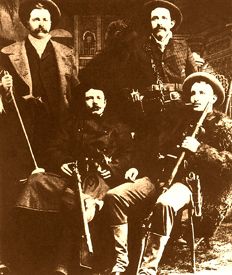
The James-Younger Gang – Left to right: Cole” Younger, Jesse Woodson James, Bob Younger, and Frank James.
Reconstruction officially ended in 1875 and Corinth continued to flourish. During these growth years, someone else took notice of Corinth’s prosperity — outlaws. On December 7, 1874, four armed men robbed the Tishomingo Savings Bank of $5000 in cash and $5000 worth of jewelry. Thought to have been none other than the James-Younger Gang from Missouri, a Corinth newspaper reported:
“Four well-mounted men rode up to the Tishomingo Savings Bank; two entered and locked the door, and two remained outside. They demanded the safe keys, which President Taylor refused. They then made an attack on him with knives and compelled him to submit. They took over five thousand dollars in currency, and much more in watches and diamonds. Mr. Taylor was not badly hurt. A negro man was in the bank making a deposit at the time and was not permitted to leave until the robbers retired. They were in the bank about fifteen minutes… The men had been lurking about the town and country for two weeks. The robbers fired several shots as they started, and rode in the direction of the Tennessee River.”
Over the following years, the city developed a number of cultural and recreational venues including an Opera House, the Henry Moore Museum, Mooreville Zoological Park, and the Coliseum, which still stands today. It also drew several manufacturing companies, mills and factories. In December 1924, Corinth’s downtown district was devastated by a terrible fire. After a fight of more than six hours in bitterly cold weather, the fire department succeeded in confining the blaze to the single block. However, the blaze destroyed more than 30 stores, resulting in more than $1,500,000 in losses. Among the buildings destroyed were the post office, a jewelry store, the opera house, the Corinth Bank and Trust Co., a merchandise store and the Ford museum.
Today, Corinth is often referred to as Mississippi’s Gateway City due to its location in the northeast corner of the state. In addition to its many Civil War sites, Corinth provides a number of other historical attractions that are well worth a visit.
Other historical attractions include the Black History Museum of Corinth, several historic businesses, the Coca-Cola Museum, the Coliseum Theater, and much more.
More Corinth Area Attractions:
Black History Museum of Corinth – Displays memorabilia and artifacts relating to the history of Corinth’s African American residents with an emphasis on education and religion. Collections include tributes to Corinth’s first black Mayor, Mayor E.S. Bishop; entertainers such as opera singer, Ruby Elzy; local and nationally known sports figures; African art and artifacts; and artifacts from local historically black churches and former segregated black schools. 1109 Meigg Street, 662-665-8500.
Coca-Cola Museum – The story of Coca-Cola has enthralled people since its beginning in 1886. Thousands of people collect, buy, sell, and swap almost every article ever stamped with the famous Coca-Cola trademark. In 1905, Avon Kenneth Weaver bought an interest in the Corinth Bottle Works, a small soda water plant. At that time, Coca-Cola was being produced in Jackson, Tennessee, and shipped by rail to Corinth. Mr. Weaver obtained a Coca-Cola franchise for Northeast Mississippi in 1907. The company is still owned by the same family. The exhibits in the museum include historical images, artifacts from the past 100 years and interactive computer stations with information about the 100 years of Corinth Coca-Cola. 305 Waldron Street, Corinth, Mississippi 662-284-4848.
The Coliseum Theater – Benjamin Franklin Liddon, a local banker and civic leader, designed and constructed the Coliseum Theater in 1924 with a capacity of 999 seats. The theater is a showplace of Victorian and Art Deco Design. Such elements as black and white tile, ornamental plaster on the ceilings, imported white marble wainscoting and a grand staircase warrant its inclusion on the National Register of Historic Places. It is also a Mississippi Landmark. Originally designed as a palatial multi-purpose theatre, the Coliseum has accommodated both live and screen performances in its acoustically perfect auditorium. Traveling Vaudeville Shows came to Corinth by rail to perform in the Coliseum. Child stars often performed here and later became nationally-known as adult actors. During the early days of the movie industry, a theatre organ in the orchestra pit accompanied the silent screen performances on a screen dropped from the fly area over the stage. Later, “Talkies” arrived and traveling performances by musicians from the Grand Ole Opry and the rock and roll of the Elvis Presley era and others all became a part of the Coliseum’s rich repertoire. In more recent years the Coliseum was the most visited movie theatre in the area and since 1981 has served the Corinth and Alcorn County area as a civic and performing arts center for a myriad of events among diverse groups. Open for tours by appointment, 404 Taylor Street, Corinth, Mississippi 38835, 662-284-7440.
Historic Downtown Corinth:
-
Biggers Hardware – This hardware store opened its doors in 1918 and has been a mainstay in the community ever since. The store’s ownership is in the fourth generation of the Biggers family.
-
Borroums Drug Store – Founded in 1865 by former CSA army surgeon A.J. Borroum, this is the oldest drug store in continuous operation in Mississippi. It houses Native American artifacts, Civil War relics, and an authentic, working soda fountain. This business has been owned and operated by the Borroum family since its founding. One specialty of the diner part of the soda fountain is a local favorite called a slugburger. Slugburgers are a Depression-era “burger” of meat and breading or soy meal. There’s even a Slugburger Festival every year to celebrate this local delicacy.
-
Waits Jewelry and Fine Gifts – This is the oldest business in Corinth dating from 1865. The store’s second generation of ownership was Earnest J. Waits, a true “renaissance man.” Not only was he a watchmaker and jeweler, but he constructed an “aeroplane” from plans in Popular Mechanics and its flights in Corinth were the first in Mississippi and probably in the Deep South. He built an early wireless telegraph, an X-ray machine, and painted beautiful seasonal murals in the building. A small area of the store is dedicated to him and his wife Eugenia who was the last family member to own the Store in 2004.
For those interested in venturing beyond Corinth into Alcorn County, visit Jacinto Courthouse located off Hwy 356, approximately eight miles east of Rienzi. Completed in 1854, the two-story federal style courthouse tells a compelling story of bygone glory days of a bustling southern boomtown. Rienzi, itself, is interesting in its own way. Though not a ghost town, supporting about 300 people, most of its business buildings are ghost town-ish looking, testifying that Rienzi’s heydays have obviously faded. Rienzi was also a very active site during the Civil War activities in Corinth.
© Kathy Weiser/Legends of America, updated November 2019.
Also See:
Civil War Battles of Mississippi

